Longus Colli Muscle Anatomy
Table of Contents
What is Longus Colli Muscle?
- Longus Colli is a paired muscle situated on the anterior surface of the vertebral column. As such, it is often known as anterior prevertebral muscle along with the longus capitis, rectus capitis anterior, or the scalenus anterior muscles. The longus colli muscle (‘long muscle of the neck) is also called as longus cervicis since it spans the entire cervical spine or the 1st 3 thoracic vertebrae. By working on the cervical vertebrae, longus Colli is responsible for forwarding or the lateral flexion of the neck, as well as the rotation of the neck.
Relations of the Longus Colli Muscle
- Longus Colli, or all prevertebral muscles, are situated deeper in the prevertebral fascia, which is a layer of the deeper cervical fascia of the neck. The muscle locates in the groove created by the pathway of the transverse process with the vertebral body, posterior to the retropharyngeal space. Therefore, the esophagus, trachea, thyroid gland, or the muscles of the hyoid (supra-, infra-) are all located anterior to it. Longus Colli is bordered medially by the cervical plexus, brachial plexus, or the subclavian artery.
- The medial border of the scalenus anterior muscle is located next to the lateral border of the longus Colli. Here, a pyramidal space is created, with the 1st section of the subclavian artery creating its base. The thoracic duct, cervical sympathetic trunk, or the 1st part of the vertebral artery (V1) are all located within this pyramidal space, crossing between the longus Colli or the scalenus anterior muscles. The cervicothoracic ganglion is also located lateral to the longus Colli muscle at the level of the 7th cervical vertebra.
- Posterior to longus Colli, 1 can find the carotid artery (including the carotid sheath) or the phrenic nerve. These are located anterosuperiorly to the tubercle of the transverse process of the 6th cervical vertebra. In addition, the inferior thyroid artery follows a medial course inferior to this tubercle or then descends nearer to the longus Colli muscle towards the thyroid gland.
- The beginning of the vertical or the inferior parts of the longus Colli represents the deeper structures of the superior mediastinum.
Origin
- Longus Colli travels the entire length of the neck; between the atlas (1st cervical vertebra) or the T3 (3rd thoracic vertebra). It is narrow at its superior or the inferior ends & has a wide central section. The muscle consists of 3 parts which are joined to the vertebral column through tendinous slips:
- Superior oblique part – begins from the anterior tubercles of transverse processes of the 3rd, 4th, and 5th cervical vertebrae (C3 to C5).
- Vertical intermediate part – begins from the anterior surfaces of bodies of the lower 3 cervical or the superior 3 thoracic vertebrae (C5 to T3).
- The inferior oblique part – is the tiniest section of the longus Colli muscle. It originates from the anterior surfaces of bodies of the 1st 3 thoracic vertebrae (T1 to T3).
Insertion
- Superior oblique part – The muscle ascends slowly in a superomedial direction to diverge on the anterior tubercle of the anterior arch of the atlas (C1).
- Vertical intermediate part – This muscle section ends into the anterior surface of the bodies of the 2nd, 3rd, or 4th cervical vertebrae (C2 to C4).
- The inferior oblique part – It ascends superolateral, diverging into the anterior tubercles of transverse processes of 5th or 6th cervical vertebrae (C5 to C6).
Nerve Supply
- Longus Colli muscle is nerve supply by the anterior rami of the 2nd to 6th cervical spinal nerves (C2 to C6).
Blood Supply
The blood supply to longus Colli arrives from the muscular branches of the following 3 arteries:
- From the Vertebral artery
- From the Inferior thyroid artery
- From the Ascending pharyngeal artery
Action
- It works as a Bilateral contraction: Neck flexion
- It also works as Unilateral contraction: Neck contralateral rotation, and neck lateral flexion (ipsilateral) same side.
The function of Longus Colli Muscle
- Bilateral contraction of the muscle responsible for flexion of the neck (i.e. forward movement). Unilateral contraction, especially of the inferior oblique part, also causes weak lateral flexion (ipsilaterally or same side) or the contralateral rotation of the neck. However, some sources doubt the unilateral work of longus colli due to its almost mid-sagittal position. These actions have necessary stabilizing functions for the vertebral column, aligning the head or the neck for upright posture.
Clinical Significance of the Longus Colli Muscle
- Calcific tendinitis
- Calcific tendinitis of the longus Colli muscle occurs because of the deposition of the calcium hydroxyapatite crystals in the tendons of the longus Colli muscle. Acute calcific tendinitis of the longus Colli muscle will occur. The Calcific tendinitis presents with acute onset of neck pain, stiffness, dysphagia, or odynophagia, or must be differentiated from the retropharyngeal abscess or any other sinister conditions. Imaging diagnosis is by CT or MRI, illustrating calcification in the muscle in addition to retropharyngeal edema. Symptoms include Neck pain, Pain in swallowing, Abnormal swallow, Decreased neck motion, or Fever. Treatment consists of non-steroidal anti-inflammatory drugs.
- Whiplash-
- Longus Colli is a large skeletal muscle of the neck which is responsible for flexing the neck or the head. The longus colli is part of a group of muscles known as the deeper flexor muscles, which give neck stabilization. Whiplash is the most general cause of injury to the longus Colli. During whiplash, the jerking back of the head might cause trauma to the cervical spine or it can slightly tear and dangerously rip a few muscles in the neck including the longus Colli. Muscle spasms will result from whiplash or it might alter the curvature of the spine. The portion of pain is on the bedside or backside of the neck. Treatments consist of the use of analgesics, anti-depressants, muscle relaxants, or the cervical collars
Strengthening Exercise For Longus Colli Muscle
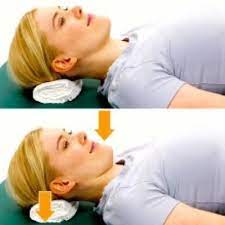
Head Nod Exercise
- In the supine position as a chin tuck, without using the pillow, tuck the chin in.
- Keeping the head straight; elevate the head off the floor about 3 or 4 inches.
- Maintain the position for 20 secs.
- Repeat this exercise by completing 2 sets of 5 reps.
- Perform this exercise 3 times a day to get better results.
Anterior stabilization lying head lift and rotation
- Lie flat on the back & then place the fingers slightly beneath the jaw till you feel the front neck muscles.
- Smoothly tuck in the chin or slightly lift the head about 1cm off the floor. Then slightly rotate the neck a few cms to each side slowly.
- Depending on the individual type of fitness, maintain the position for a minimum of 2 secs up to 5 secs per rep. Aim for 5 to 10 reps at a time in sets of 2 to 3.
Superman Exercise
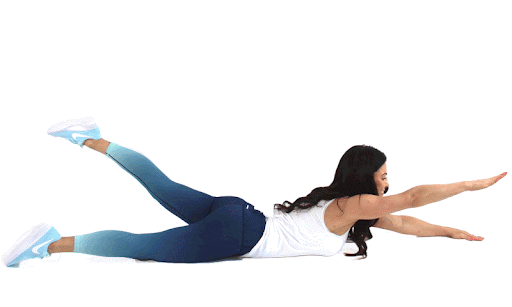
- Do this exercise on a mat or a firm floor. Sleep down flat on the stomach while the arms extended outside straight of the body.
- The legs should be maintained flat on the ground, as well as the arms.
- Lift the arms or the legs simultaneously like you are trying to fly. squeeze the lower back. Make sure to respiration occur properly.
- Depending on the individual type of fitness, maintain the position for a minimum of 2 secs up to 5 secs per rep. Aim for 5 to 10 reps at a time in sets of 2 to 3.
- Individual fitness levels will determine how many reps or sets the individual is capable of doing at a single time or in a single day.
Chin to chest Exercise
- Get into a sitting position on the ground. Put 2 hands at the base of the head with fingers interlocked.
- Staring the thumbs down or the elbows extended ahead.
- Do the head down to the chest or just hold it for 20 to 30 secs.
- Do ten reps of this exercise.
Theraband rows
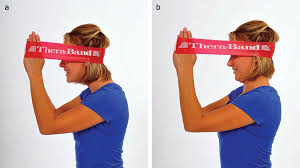
- First Place the theraband around a doorknob or hold with your hand as shown in the figure& tie a knot in the theraband & close it in the door.
- The band is at chest level.
- You are standing tall or sitting straight with each end of Theraband grab behind the head or the knee joint slightly bent, abdominal muscles tight.
- Must be Maintained the tight trunk muscles & pull the head back while squeezing the shoulder blades and neck muscle contraction together.
- You are trying to focus on squeezing the shoulder blades without shrugging the shoulder joint up towards the ears or pulling the head backward.
- Then back to starting position but Do not lean back.
- Hold this exercise position for 10 seconds.
- Perform the 10 times in 1 session & 3 sessions per day.
Head lifts
- You are Lie flat on the back with the arms stretched to the sides.
- Nod the head & tuck in the chin.
- Hold this exercise for a few seconds before releasing back to a neutral position.
- Hold this exercise position for 10 seconds.
- Perform the 10 times in 1 session & 3 sessions per day.
Seated Clasped Neck Stretch
- You are sitting comfortably on the floor & in a chair.
- Must place your body in proper alignment.
- Then Clasp the hands & bring both palms to the back of the head.
- Try to slowly press the hands down toward the thighs & tucking the chin into the chest.
- Maintain this stretching position for 30 secs.
- Perform the three times in one session and three sessions per day.
Seated Tucked in Exercise
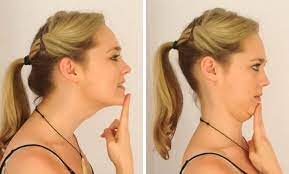
- The patient’s position should be Sitting straight & look straight ahead with the ears level parallel over the shoulders joints.
- Place 3 to 4 fingers on the chin.
- Maintain the finger, pull the chin & head extended beside up to a slowly stretch is felt at the bottom of the base of the head & top of the neck.
- Maintain or hold for 5 to 10 secs. Repeat seven to ten times.
Neck flexion Exercise (Neck tilt)

- In Relax sitting position flex the head down to rest the chin on the chest (Flex the neck fully).
- Gently tense the neck muscles & hold for 4 to 8 secs.
- Return to the initial position & repeat seven to ten times.
Neck retraction exercises
- Sit on soft ground or a chair & then engage the core to help stabilize the spine.
- Brace the posterior muscles in the neck to bring the head back into a steady position while having the chin slightly downward.
- Maintain the position briefly.
- Relax & then repeat.
- Start with 1 set of 5 reps and work the way up to ten reps in total.
Isometric Neck extension exercise
- In Relax sitting position without arching the back, slowly move the head backward so you are looking upward.
- Hold for 5 to 10 secs. Return to starting position.
- This is a good exercise to do during working hours to prevent neck strain.
- Gently tense the neck muscles & hold for 5 to 10 secs.
- Return to a neutral position & repeat 10 times.
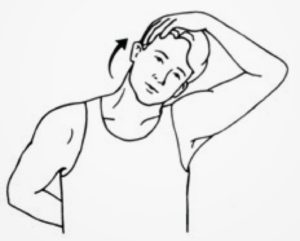
Neck flexion Exercise (side to side)
- Flex the head down towards the shoulder, & try to touch the shoulder with the ear (Without elevating the shoulder).
- Gently tense the neck muscles & hold for 8 secs.
- Return the head to a neutral position & repeat in the opposite direction.
- Repeat 10 times on both sides.
Isometric Neck Rotation exercise

- Begin this exercise by doing a rotation of the head towards 1 side, keeping the chin at the same level & moving within normal limits.
- Slowly stretch the neck muscles & hold for eight secs.
- Back the head to the neutral position & repeat in the other direction.
- Repeat 10 times on each side.
Revolved Triangle Exercise
- Begin this exercise by standing with the feet about four feet apart.
- Face the right toes forward & the left toes out at a slight angle.
- Square the hips & face forward in the same direction the right toes are pointing.
- Lift the arms up at the sides so they are parallel to the floor.
- Slowly hinge at the hips to fold forward, stopping when the torso is parallel to the floor.
- Place the left hand to the leg, the floor, or a block, up to you can reach.
- Straighten the right arm straight up with the palm seeing away from the body.
- Turn the gaze to look up close to the right thumb.
- Exhale to rotate the neck to look down at the surface.
- Inhale as you back the gaze upward.
- Maintain the rest of the body stable & continue these neck turns as you stay in the pose for up to one min.
- Do on the alternate side.
Upward Plank Exercise
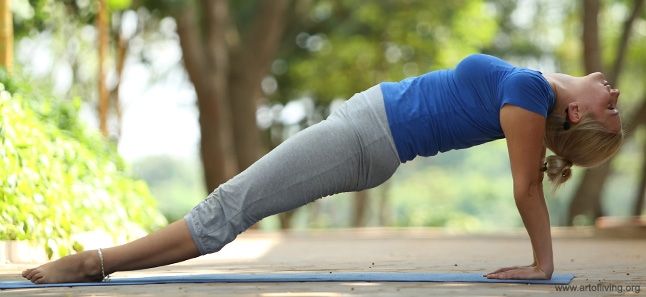
- This pose allows you to passively hang the head back & down, releasing tension in the neck & shoulders. This lengthens & stretches the longus colli, SCM, chest, & shoulder muscles.
- Make sure the back of the neck is fully relaxed to avoid compressing the spine. If it is uncomfortable for you to let the head hang back, you can tuck the chin into the chest & lengthen the back of the neck. Precise on engaging the neck muscles without straining.
- You can also allow the head to rest back on some type of support such as a chair, a wall, or stacked blocks.
- How to do- Come into a seated position with the legs straight in front of you.
- Press the palms to the floor alongside the hips.
- Elevate the hips or place the feet beneath the knees.
- Exaggerated the pose by straightening the legs.
- Open the chest or let the head drop behind.
- Hold for up to 25 to 30 secs.
- Do this pose up to three to five times.
Prone Cobra Exercise
- This exercise begins by lying face downwards on the ground or assisting gravity as a hazard in the process.
- Put face caudal on the floor, or put the forehead on a wrapped-up hand towel for support.
- Place the arms by the side, & palms resting on the surface.
- Drag the tongue onto the upper side of the mouth.
- Squeeze the shoulder blades combine or raise the hands off the ground.
- Roll the elbows inside, palms outsides, & thumbs upside.
- Slowly raise the forehead about an inch off the towel and steady the eyes looking ahead forward at the ground.
- Steady the position for seven to ten secs.
- Do it 7 to 10 times.
Isometric Neck Exercise
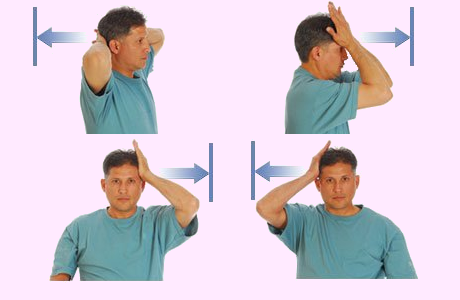
- Isometric neck exercises assist to strengthen the neck muscles. This exercise is commonly prescribed by Physiotherapists from day 1 to alleviate Neck pain.
- Isometric Neck Exercise
- How to perform this exercise In a sitting alignment,
- keep the Body steady and straight, Place both hands beside the neck (as seems in the images), & try the neck to push compress on the hands & At the same time Resist the neck muscles, both hands steady and align pattern for 4 to 5 secs & then relax.
- The first day does 8 reps & the 2nd day does 10 reps. Do some exercise on the forehead & each side of the neck.
- Do the exercise by compressing the side of the head. Repeat 8 times, then opposite sides.
Prone Rows Exercise
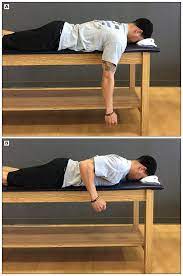
- Lie down on the stomach with the arms dangling off the side of the bed (just angling the body so the head is turning the corner of the bed).
- Use a pillow below the stomach for comfort. Start by pulling your arms back while bending elbows & contracting the shoulders blades together then gently back to the initial position.
- Do not raise your head up while pulling the arms back.
- Repeat twenty times. Perform two times a day.
Standing pushups exercise
- Stand about an arms-length down from the wall with the bases spread piecemeal.
- Place the hands on the wall, making sure that they parallel with the shoulders.
- Keeping the reverse straight, sluggishly bend or flex the elbows, bringing the upper body toward the wall.
- Extend the elbows & back to the initial position.
- Repeat twenty times. Perform two times a day.
Tilted forward flexion exercise
- Sluggishly lean the head to the leftism. Using the left hand for resistance, use the muscles in the neck to press against it. Hold for 5 to 10 secs, also return to starting position.
- Also, sluggishly lean the head to the other side. Hold for 5 to 10 secs.
- Return to starting position. Do 10 repetitions. This is a good exercise to do during work, especially if you have to keep the head in a steady position for a prolonged time as in working at a computer. Do this exercise every partial hour to help with the prevention of neck tightening.
Stretching Exercise for Longus Colli Muscle
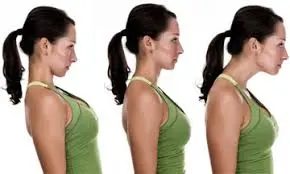
Longus Colli Forward and backward stretches
- Sitting on the edge of a chair with the back straight & the chin should be parallel to the floor.
- Tilt the head forward gently until the stretch is felt in the back of the neck. Hold for 5 secs.
- Lift the chin & then tilt the head back until the stretch is felt in the upper neck.
- Hold for 5 secs.
- Perform the exercise for ten reps periodically throughout the day to relieve a longus Colli neck strain.
Suboccipital Muscle Stretch
Manual Stretching
- Patient position & the procedure: Sitting
How to do:
- Marked the spinous process of the 2nd cervical vertebra or afterward stabilize it with the thumb or with the second metacarpophalangeal joint (or with the thumb or the index finger surrounding the transverse processes).
- Tell the patient smoothly nod the head, doing just a tipping action of the head on the upper spine. Illustrate the motion by putting the different hands across the forehead of the patient.
- You can hold for 25 to 30 secs & then do three reps.

- Patient position and procedure: Supine
- How to do:
- Sitting on a stool at the head of the treatment table while the forearms are resting on the table. 1 hand stabilizes the C2 vertebra by grabbing the transverse processes between the proximal part of the thumb or the index finger; the opposite hand assists the occiput.
- Nod the head of the patient with the hand below the occiput to take up the slack of the suboccipital muscles; then tell the patient to roll the eyes upside.
- This creates a gentle isometric contraction of the muscles of the suboccipital. Afterward maintaining for 6 secs, tell the patient to roll the eyes downward.
- As the suboccipital muscles easy, take up the slack by passively nodding the head through a new range of motion. The only movement should be happening between the occiput or the C2.
- The contraction is slow in order to not cause the overflow into the multi-segmental erector spinal muscles or the upper trapezius muscles.
- You can hold for 30 secs them repeat three reps.
Self-Stretching
- How to do:
- Patient position & the procedure: Supine or sitting. Explain to the patient to nod the head, and place the chin nearer to the larynx till a stretch is felt in the suboccipital region. Just gave a minor pressure beneath the occipital area with the palm of the hand while tipping the patient’s head forward will reinforce the motion.
- You can hold it for 30 secs & then repeat three reps of it.
Longus Colli Muscle Stretch
- The longus colli muscle (of the transversospinalis group) is stretched by flexing the head & the neck at the spinal joints.
- Prefix in lateral flexion (not seems in the accompanying demonstration) will be increasing the efficacy of the stretch for the different-side longus Colli muscle.
- You can hold for 30 to 40 secs & the three to five reps.
Deeper Stretch to Colli Muscle
- The left side longus colli muscle is stretched by flexing, the right laterally flexing, & the right rotating the neck at the spinal joints, while the left side of the shoulder girdle is signed to raise.
- You can hold for 30 to 40 secs & the three to four reps.
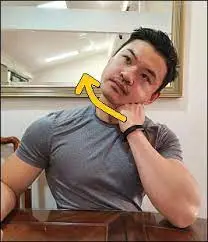
Table Longus Colli Stretch
- Sitting in front of a table.
- Keep the chin in & down throughout this stretch.
- Place the left fist on the left side of the chin.
- Place the left elbow onto the table in front of you.
- Rest the weight of the head onto your fist.
- Tilt the head to the left.
- Apply more pressure to the chin to gear up the stretch.
- The goal is to feel a firm stretch on the right side of the neck.
- Hold for 30 secs.
- Perform on the alternate side.
Stretch to Colli Muscle
- Tuck the chin in & downwards.
- Tilt the head to the right.
- Put the right hand on the opposite side of the head.
- Apply downward compression.
- Slowly turn the head to the left.
- The goal is to feel a firm stretch on the left side of the longus Colli muscle.
- Hold for 30 secs, 3 rep.
- Repeat on the alternate side.
Longus Colli Stretch Alterations
- Place the fingers on top of the left side collar bone.
- Pulling the skin down.
- Tuck the chin in & down.
- Slowly turn the head towards the left side.
- Tilt the head towards the right side.
- The goal is to feel a stretch on the left side of the longus Colli muscle.
- Hold for 30 secs, 3 rep.
- Repeat on the alternate side.
Chair Lean Stretch
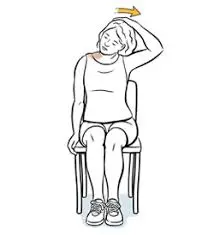
- Sitting down on a chair.
- By using the right hand, grab onto the side of the chair.
- Keep the shoulder completely relaxed.
- Leaning the body completely towards the left side.
- Then tuck the chin in & downwards.
- Tilt the head towards the left.
- Place the left hand on the right side of the head.
- Apply downward compression.
- The goal is to feel a stretch on the right longus Colli muscle.
- Hold for 30 secs, 3 rep.
- Repeat on the alternate side.
Neck Elongation Stretch
- Tuck the chin in & caudal.
- Now Slide the head towards the left side.
- Then Elongate the left side of the neck in an upwards direction.
- The goal is to feel a stretch on the left side of the neck.
- Repeat on the different sides.
- Perform 25 to 30 times, 3 sets rep.

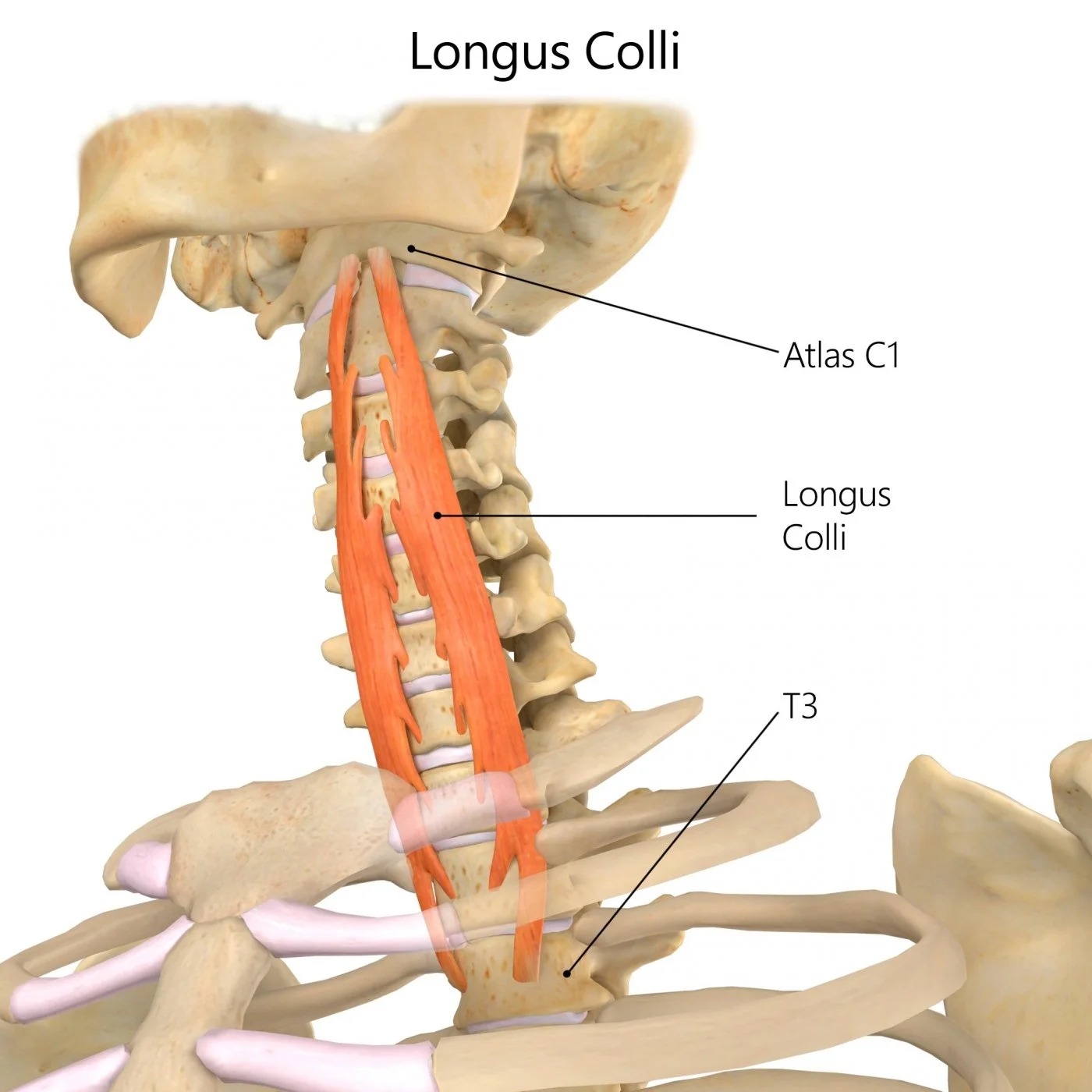
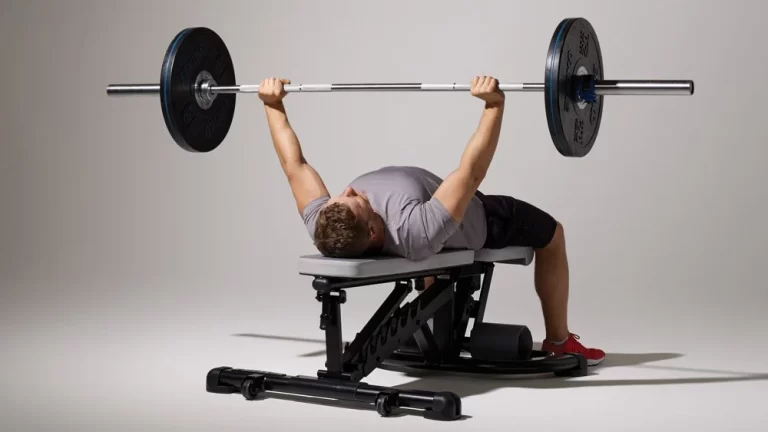

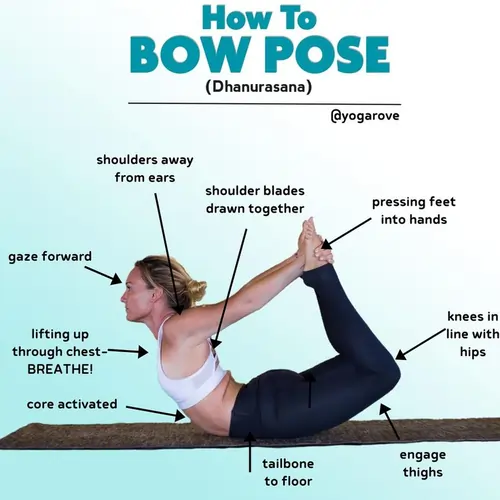



One Comment